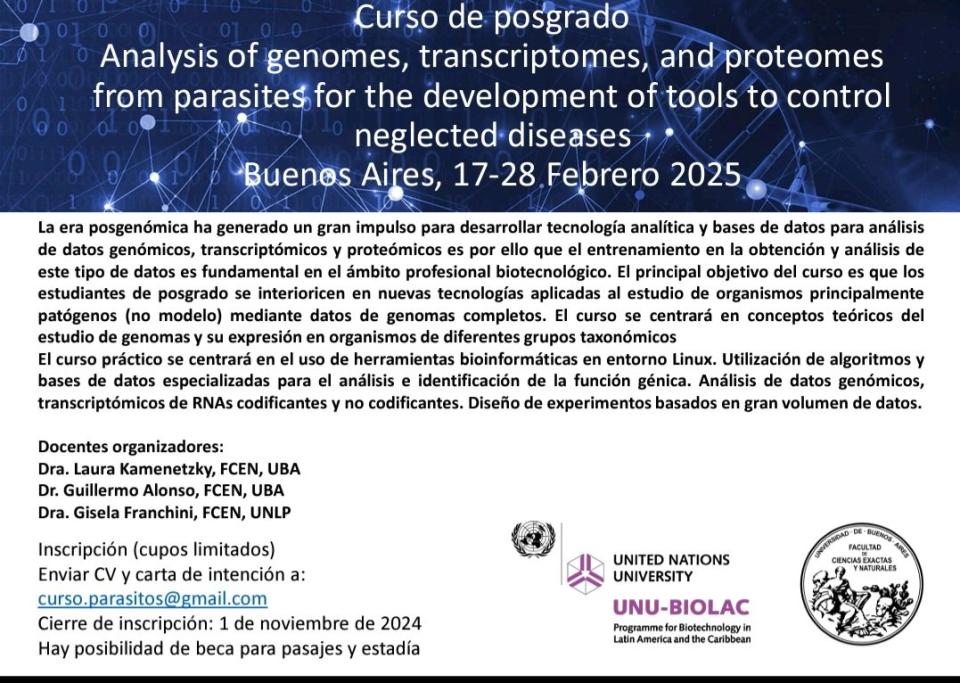All the information needed to understand a parasite is in its genome, but getting from the genes to the
Learn to navigate the layers of information that conceal the genomic bases of pathogenicity by using the latest bioinformatic technology for proteomic, transcriptomic, and genomic analysis.
As we enter the post-genomic era, genome-wide expression profiling methods at the transcriptome and proteome levels have come to the fore. Over recent years, there has been a tremendous drive to develop analytical technology and databases for 'transcriptomics' and 'proteomics.' Still, integrative analysis strategies for this omic data have yet to emerge. The main aim of the course is to provide tools to overcome this hurdle and allow students to truly focus on fully integrative aspects of parasite phenotypes and environmental adaptations. The practical course will focus on using bioinformatics tools in a Linux environment, assembling genomes, analyzing transcriptomic data of coding RNAs, and using specific tools to analyze and discover small non-coding RNAs.
The course's main objective is for postgraduate students to become acquainted with new technologies applied to studying pathogens (viruses, bacteria, fungi, protozoans, helminths) using whole genome data. The course will focus on theoretical concepts of the study of genomes and transcripts of organisms of different taxonomic groups and the search for biomolecules of biotechnological interest.
The realization of this course will also consolidate the collaborations between researchers from Argentina, who have vast experience in the subject through different complementary approaches (bioinformatics, biochemical, molecular, and cellular). This course will allow students to contact teachers/researchers from Latin America, enable the creation of new links, and allow students access to cutting-edge technologies such as massively parallel sequencing of genomes and transcripts and analysis of large numbers of data. In this way, the contribution of diverse points of view, based on the specialties of each of the teachers, will allow them to complement the knowledge among themselves and approach the present course's theme in a truly interdisciplinary way.
Activity Description
Theoretical:
1. Strategies for generating and analyzing x-omic data
1.1. Generation of genome and transcriptome data: strategies currently available.
1.2. Assembly and genome annotation: available tools and current limitations.
1.3. Structural and functional characteristics of the genomes of different taxonomic groups.
1.4. Data integration and information extraction of biotechnological application.
1.5. Development and use of tools for discovering small RNAs from genomic data.
1.6. Search and analysis of small RNAs as biomarkers in diseases.
2. Identification of disease targets from x-omic data 2.1. Infectious diseases
2.1. diagnosis and follow-up of infectious diseases: difficulties and challenges.
2.2. miRNoma of parasitic Platyhelminthes: expression throughout the development and possible biotechnological applications.
2.3. identification and characterization of antigens for use in developing diagnostic methods of orphan helminthiasis.
2.4. Immunoinformatics applied to the identification of diagnostic candidates.
2.5. discovery of new therapeutic targets in infectious diseases.
Practical:
Wet-lab: gDNA sequencing library construction (barcoded) and loaded to MinION Nanopore Sequencing Platform.
Dry lab: Hands-on bioinformatics tools for genome assembly of Nanopore data obtained in a wet lab. Transcriptomic analysis of published data from coding RNAs and specific tools for identifying small non-coding RNAs. Use of specialized algorithms and databases for analysis and identification of therapeutic targets. Use pathogen databases and strategies to extract information (EupathDB, WormBaseParasiteDB)—bioinformatic tools for proteomic data analysis.
Target audience: Graduates or Masters or Doctorates in careers related to life sciences (Biotechnology, Biology, Biochemistry, Genetics, Veterinary Medicine, Medicine, and related). Other majors will be contemplated if the postgraduate student has specialized in the subject matter (for example, a Bachelor of Computer Science doing the Doctorate in Bioinformatics).
Application procedure
Applications and further information will be managed via email: curso.parasitos@gmail.com
For applications, send CV and Cover Letter to te specified email address.
Deadline: November 1st, 2024.

